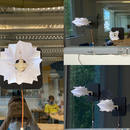Introduction: How to Make an Automatic Light Up LED Strip W/ Photocell
I am fascinated with projects that are automatic and have LED lights. This project is for one of my class assignment, and it is so simple to set up without the extra cost of Arduino. It's an analog circuit board so the cost of the project is extremely low and under-budget because what we are going to use is the 555 timer as the microcontroller for this project.
Within this tutorial you will know the the 555 timer works, transistor, and create your own adapter for the LED strip light. Follow these step-by-step instructions on how to assemble the circuit with the bread board. While doing this project if you have prototype board (it's like a workspace to test out your circuit) in hand that would make this project testing much easier, if not then using the breadboard (like the one we will use in my instruction) you are ok too. You can have the option to solder this circuit permanently into a perfboard (similar to this Instructable) it would last long and sturdy for outdoor environment.
Because who want to manually turn on the light outside (garden light, drive way light) by hand, or physically go outside to turn it off or on. You can adapt this to make the automatic Christmas light for your house (or Halloween, or Lunar New year, or Hanukkah, or any holidays). We want to automate everything!
Supplies
You will need the following but feel free to make adjustment to fit your projects:
- 1 555 Timer
- 2 100K Dimmers (any 100K dimmer would work)
- 2 1N4148 Diode
- 1 2N3904 Transistor
- 1 LDR Photocell
- 1 220 Ohm Resistor
- 1 10K Ohm Resistor
- 1 1M Ohm Resistor
- 1 10n F Capacitor
- 1 100n F Capacitor
- 1 RGB LED Strip Light (most variety run with 12V power supply)
- 1 12V 1A AC Adapter (the circuit can take any power between 10 to 12V)
- 1 Breadboard
Besides that, you are also recommended to have these tools to aid your works:
- Soldering iron and solder (if you want to make it into a permanent circuit pad)
- Prototype board
- Wire jumper (for the breadboard)
- Wire cutter
- A Multimeter
In this project I will not make the prototype board instruction. Mostly we will build it on the breadboard and you can decide it permanent.
NOTE: In the photo you maybe an extra resistor, I used that to controlled the color of the RGB LED to make it purple-ish color by letting blue and some red light in.
Step 1: Understanding the Circuit
The power supply will be use to supply the circuit and the LED strip light. The 555 timer will detect the change in light through the LDR photocell. In the schematic, the photocell works by letting current running through it when there is bright light shining onto it.
How does the photocell send signal to the 555 timer to switch on the light?
The dimmer in the region above is use to only let some threshold of the LDR photocell to trigger the on and off of the LED light. By adjusting that dimmer we can adjust how low the brightness of the light can be in order to switch on the LED.
Notice in the schematic, we can see the connection between the LDR photocell area with the gate 4 (reset pin) in the 555 timer. Because the reset pin (4) is used as the switch for the photocell, what it will do is reset the internal flip flop of the 555 timer (as seen in this very good and detailed image about 555 timer) when the photocell detects lights. The 555 timer is essentially in a bistable mode which trigger the output state ON or OFF, it pulls the reset pin low when it is in dark, which will send a high voltage signal into the base of the transistor (as seen in the bottom area of the schematic) to switch on the LED lights.
Since we also want to control the LED strip light, another dimmer is used in the schematic to deal with that. The dimmer at the bottom works by letting some current running to the ground by the changing of the dimmer (a changing resistor). If the dimmer turns to a lower resistance value then some current can over run it and get redirect to the ground.
Step 2: Wiring the Photocell
Step 2 is out first step in making the circuit. We starts by making the photocell connection with 555 timer. Positioning the 555 timer in the middle of the breadboard. Notice how I connect between the spine of the board.
The 100K dimmer has 3 gates, you will wire the middle gate to Reset gate of the 555 (Gate No. 4). The current will run from reset to the flipflop inside 555 to connect the output gate. There is also some current running inside the 555 timer that we want to release back to the ground through control voltage gate (Gate No.5) and threshold gate (Gate No.6). For those two we will connect later.
After connecting middle gate of dimmer to gate 4, go ahead and connect two other gate of the dimmer to the source and ground. For the source, make sure you wire with a 1M resistor to control the voltage and current running through the dimmer and later the PDR Photocell. place the LDR Photocell between the ground connection of the dimmer.
Step 3: Wiring LED Light Dimmer and Transistor
Next onto the bottom half of the circuit, we will wiring the dimmer for the LED light and the transistor to control the turning on and off from the out of the 555 timer. Similar to the dimmer we do from step 2, the middle gate of the dimmer will connect to the output gate of 555 timer (Gate No.3), make sure to wire the 10K ohm resistor between them. Gate 3 of 555 also connect to the Base gate of the resistor (it is the middle leg of the 2N3904 transistor), make sure to also wire the 222 Ohm resistor before connect to the Base leg (B).
Connect the Emitter led (C) of the transistor the ground.
Within the dimmer circuit, you will use 2 diode to connect the other gates. One of the diode will have its anode(+) points toward a gate of the dimmer, the other one will have its cathode(-) points toward the last gate of the dimmer. Then wire the diode to threshold gate (Gate No.6) of 555.
Trigger gate (Gate No.2) of 555 timer need to connect to gate 6, we will later wire gate 6 and 5 to capacitors.
Step 4: Connect LED Strip Light Into the Circuit
We will finishing up the connection of Gate 6 and 5, and the LED strip light in this step. For gate 6, before wire it to the ground make sure you wire the 100n capacitor. Gate 5 is the same but it is the 10n F capacitor.
The strip light I used in this project is RGB (Red Green Blue) LED light. To make the LED light up with the color you want (in this case I want to be purple) I need to get the source into the strip and out through the color legs I want (blue and some red).
Using color theory for light, purple light is made up of blue light and red light, depending how strong your purple light is lowering the Red light will help your outcome. I place a small resistor (50-2 Ohm) between the blue and red connection as there is 100% source out of blue and some out of the red (i want my purple light more blue-ish). If let red out a lot then the color will be pink.
Connect the Collector led (C) of the transistor to the color legs of the LED strip. Wiring the source into the 12V+ leg of the LED strip.
Step 5: Finishing Up the 555 Timer
We will not wire anything into gate 7 of the 555 timer so make sure that gate stays clean. Connect gate 1 to the ground, and gate 8 into the source. Your circuit is now done. All to need to do now is hook the board into the power source which is the 12V 1A adapter.
Step 6: Adjust Sensitivity of the Photocell
To help your photocell detect the change between afternoon sunlight and night, place your cell outside during afternoon, and twist the dimmer of the photocell back a little after you make the LED light turn on. This will ensure that it will turn on the LED when the sun is down. You can change the brightness of the LED why changing the bottom dimmer.
Your circuit is ready to place anywhere outside (make sure you have good connection and dry place for it). You can make it water tight by placing it inside a box and seal off any holes.
Step 7: Share Your Project
You can come up with any kind of adjustment for the project, and it is good to share so comment and post your result down here ⬇️

Participated in the
Make it Glow Contest











